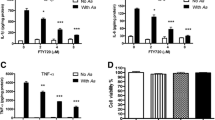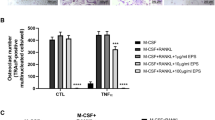Abstract
Human beta-defensin-3 (HBD3), which is secreted from cells in the skin, salivary gland, and bone marrow, exhibits antimicrobial and immunomodulatory activities. Its C-terminal end contains a 15-amino acid polypeptide (HBD3-C15) that is known to effectively elicit antimicrobial activity. Recently, certain antimicrobial peptides are known to inhibit osteoclast differentiation and, thus, we investigated whether HBD3-C15 hinders osteoclast differentiation and bone destruction to assess its potential use as an anti-bone resorption agent. HBD3-C15 inhibited the receptor activator of nuclear factor κB ligand (RANKL)-induced osteoclast differentiation and formation of resorption pits. In addition, HBD3-C15 disrupted the formation of RANKL-induced podosome belt which is a feature typically found in mature osteoclasts with bone-resorbing capacity. HBD3-C15 downregulated cortactin, cofilin, and vinculin, which are involved in the podosome belt formation. Furthermore, bone loss induced by RANKL was significantly reduced in a mouse calvarial implantation model that was treated with HBD3-C15. Similar inhibitory effects were observed on the osteoclast differentiation and podosome belt formation induced by Aggregatibacter actinomycetemcomitans lipopolysaccharide (AaLPS). Concordantly, HBD3-C15 attenuated the resorption in the calvarial bone of AaLPS-implanted mouse. Collectively, these results suggest that HBD3-C15 has an anti-bone resorption effect in developing osteoclasts and that this occurs via its disruption of podosome belt formation. HBD3-C15 could be a potential therapeutic agent for the inhibition of bone destruction.
Key messages
-
HBD3-C15 inhibits osteoclast differentiation and bone resorption capacity.
-
HBD3-C15 disrupts the podosome belt formation in osteoclasts.
-
HBD3-C15 alleviates the bone loss by RANKL or A. actinomycetemcomitans LPS in vivo.






Similar content being viewed by others
References
Long F (2012) Building strong bones: molecular regulation of the osteoblast lineage. Nat Rev Mol Cell Biol 13:27–38
Boyle WJ, Simonet WS, Lacey DL (2003) Osteoclast differentiation and activation. Nature 423:337–342
Takayanagi H, Kim S, Koga T, Nishina H, Isshiki M, Yoshida H, Saiura A, Isobe M, Yokochi T, Inoue J et al (2002) Induction and activation of the transcription factor NFATc1 (NFAT2) integrate RANKL signaling in terminal differentiation of osteoclasts. Dev Cell 3:889–901
Boyce BF, Xing L (2008) Functions of RANKL/RANK/OPG in bone modeling and remodeling. Arch Biochem Biophys 473:139–146
Lange AW, Yutzey KE (2006) NFATc1 expression in the developing heart valves is responsive to the RANKL pathway and is required for endocardial expression of cathepsin K. Dev Biol 292:407–417
Kim K, Lee SH, Ha Kim J, Choi Y, Kim N (2008) NFATc1 induces osteoclast fusion via up-regulation of Atp6v0d2 and the dendritic cell-specific transmembrane protein (DC-STAMP). Mol Endocrinol 22:176–185
Saltel F, Chabadel A, Bonnelye E, Jurdic P (2008) Actin cytoskeletal organisation in osteoclasts: a model to decipher transmigration and matrix degradation. Eur J Cell Biol 87:459–468
Georgess D, Machuca-Gayet I, Blangy A, Jurdic P (2014) Podosome organization drives osteoclast-mediated bone resorption. Cell Adhes Migr 8:191–204
Destaing O, Saltel F, Geminard JC, Jurdic P, Bard F (2003) Podosomes display actin turnover and dynamic self-organization in osteoclasts expressing actin-green fluorescent protein. Mol Biol Cell 14:407–416
Choi SW, Yeon JT, Ryu BJ, Kim KJ, Moon SH, Lee H, Lee MS, Lee SY, Heo JC, Park SJ et al (2015) Repositioning potential of PAK4 to osteoclastic bone resorption. J Bone Miner Res 30:1494–1507
Ganz T (2003) Defensins: antimicrobial peptides of innate immunity. Nat Rev Immunol 3:710–720
Dhople V, Krukemeyer A, Ramamoorthy A (2006) The human beta-defensin-3, an antibacterial peptide with multiple biological functions. Biochim Biophys Acta 1758:1499–1512
Selsted ME, Ouellette AJ (2005) Mammalian defensins in the antimicrobial immune response. Nat Immunol 6:551–557
Schibli DJ, Hunter HN, Aseyev V, Starner TD, Wiencek JM, PB MC Jr, Tack BF, Vogel HJ (2002) The solution structures of the human beta-defensins lead to a better understanding of the potent bactericidal activity of HBD3 against Staphylococcus aureus. J Biol Chem 277:8279–8289
Lin P, Li Y, Dong K, Li Q (2015) The antibacterial effects of an antimicrobial peptide human beta-defensin 3 fused with carbohydrate-binding domain on Pseudomonas aeruginosa PA14. Curr Microbiol 71:170–176
Rozek A, Powers JP, Friedrich CL, Hancock RE (2003) Structure-based design of an indolicidin peptide analogue with increased protease stability. Biochemistry 42:14130–14138
Jenssen H, Hamill P, Hancock RE (2006) Peptide antimicrobial agents. Clin Microbiol Rev 19:491–511
Lee JK, Chang SW, Perinpanayagam H, Lim SM, Park YJ, Han SH, Baek SH, Zhu Q, Bae KS, Kum KY (2013) Antibacterial efficacy of a human beta-defensin-3 peptide on multispecies biofilms. J Endod 39:1625–1629
Lim SM, Ahn KB, Kim C, Kum JW, Perinpanayagam H, Gu Y, Yoo YJ, Chang SW, Han SH, Shon WJ et al (2016) Antifungal effects of synthetic human beta-defensin 3-C15 peptide. Restor Dent Endod 41:91–97
Horibe K, Nakamichi Y, Uehara S, Nakamura M, Koide M, Kobayashi Y, Takahashi N, Udagawa N (2013) Roles of cathelicidin-related antimicrobial peptide in murine osteoclastogenesis. Immunology 140:344–351
Supanchart C, Thawanaphong S, Makeudom A, Bolscher JG, Nazmi K, Kornak U, Krisanaprakornkit S (2012) The antimicrobial peptide, LL-37, inhibits in vitro osteoclastogenesis. J Dent Res 91:1071–1077
Park OJ, Cho MK, Yun CH, Han SH (2015) Lipopolysaccharide of Aggregatibacter actinomycetemcomitans induces the expression of chemokines MCP-1, MIP-1alpha, and IP-10 via similar but distinct signaling pathways in murine macrophages. Immunobiology 220:1067–1074
Kim J, Yang J, Park OJ, Kang SS, Kim WS, Kurokawa K, Yun CH, Kim HH, Lee BL, Han SH (2013) Lipoproteins are an important bacterial component responsible for bone destruction through the induction of osteoclast differentiation and activation. J Bone Miner Res 28:2381–2391
Yoon H, Yoon YS, Kim MS, Chung MJ, Yum DY (2014) A probiotic preparation duolac-gold ameliorates dextran sulphate sodium-induced mouse colitis by downregulating the expression of IL-6. Toxicol Res 30:27–32
Hoover DM, Wu Z, Tucker K, Lu W, Lubkowski J (2003) Antimicrobial characterization of human beta-defensin 3 derivatives. Antimicrob Agents Chemother 47:2804–2809
Gil-Henn H, Destaing O, Sims NA, Aoki K, Alles N, Neff L, Sanjay A, Bruzzaniti A, De Camilli P, Baron R et al (2007) Defective microtubule-dependent podosome organization in osteoclasts leads to increased bone density in Pyk2(-/-) mice. J Cell Biol 178:1053–1064
Fuller K, Ross JL, Szewczyk KA, Moss R, Chambers TJ (2010) Bone is not essential for osteoclast activation. PLoS One 5:e12837
Prakasam A, Elavarasu SS, Natarajan RK (2012) Antibiotics in the management of aggressive periodontitis. J Pharm Bioallied Sci 4:S252–S255
Madeira MF, Queiroz-Junior CM, Cisalpino D, Werneck SM, Kikuchi H, Fujise O, Ryffel B, Silva TA, Teixeira MM, Souza DG (2013) MyD88 is essential for alveolar bone loss induced by Aggregatibacter actinomycetemcomitans lipopolysaccharide in mice. Mol Oral Microbiol 28:415–424
Linder S, Aepfelbacher M (2003) Podosomes: adhesion hot-spots of invasive cells. Trends Cell Biol 13:376–385
Matsumoto T, Nagase Y, Hirose J, Tokuyama N, Yasui T, Kadono Y, Ueki K, Kadowaki T, Nakamura K, Tanaka S (2013) Regulation of bone resorption and sealing zone formation in osteoclasts occurs through protein kinase B-mediated microtubule stabilization. J Bone Miner Res 28:1191–1202
Vives V, Cres G, Richard C, Busson M, Ferrandez Y, Planson AG, Zeghouf M, Cherfils J, Malaval L, Blangy A (2015) Pharmacological inhibition of Dock5 prevents osteolysis by affecting osteoclast podosome organization while preserving bone formation. Nat Commun 6:6218
Ray BJ, Thomas K, Huang CS, Gutknecht MF, Botchwey EA, Bouton AH (2012) Regulation of osteoclast structure and function by FAK family kinases. J Leukoc Biol 92:1021–1028
Tehrani S, Faccio R, Chandrasekar I, Ross FP, Cooper JA (2006) Cortactin has an essential and specific role in osteoclast actin assembly. Mol Biol Cell 17:2882–2895
Zalli D, Neff L, Nagano K, Shin NY, Witke W, Gori F, Baron R (2016) The actin-binding protein cofilin and its interaction with cortactin are required for podosome patterning in osteoclasts and bone resorption in vivo and in vitro. J Bone Miner Res 31:1701–1712
Fukunaga T, Zou W, Warren JT, Teitelbaum SL (2014) Vinculin regulates osteoclast function. J Biol Chem 289:13554–13564
Warnke PH, Springer IN, Russo PA, Wiltfang J, Essig H, Kosmahl M, Sherry E, Acil Y (2006) Innate immunity in human bone. Bone 38:400–408
Varoga D, Wruck CJ, Tohidnezhad M, Brandenburg L, Paulsen F, Mentlein R, Seekamp A, Besch L, Pufe T (2009) Osteoblasts participate in the innate immunity of the bone by producing human beta defensin-3. Histochem Cell Biol 131:207–218
Liu GD, Yu HJ, Ou S, Luo X, Ni WD, Huang XK, Chen JY, Wang Y, Javard P, Fei J (2014) Human beta-defensin-3 for the diagnosis of periprosthetic joint infection and loosening. Orthopedics 37:e384–e390
Paulsen F, Pufe T, Conradi L, Varoga D, Tsokos M, Papendieck J, Petersen W (2002) Antimicrobial peptides are expressed and produced in healthy and inflamed human synovial membranes. J Pathol 198:369–377
Tohidnezhad M, Varoga D, Podschun R, Wruck CJ, Seekamp A, Brandenburg LO, Pufe T, Lippross S (2011) Thrombocytes are effectors of the innate immune system releasing human beta defensin-3. Injury 42:682–686
Varoga D, Pufe T, Mentlein R, Kohrs S, Grohmann S, Tillmann B, Hassenpflug J, Paulsen F (2005) Expression and regulation of antimicrobial peptides in articular joints. Ann Anat 187:499–508
Varoga D, Pufe T, Harder J, Schroder JM, Mentlein R, Meyer-Hoffert U, Goldring MB, Tillmann B, Hassenpflug J, Paulsen F (2005) Human beta-defensin 3 mediates tissue remodeling processes in articular cartilage by increasing levels of metalloproteinases and reducing levels of their endogenous inhibitors. Arthritis and Rheum 52:1736–1745
Acknowledgements
This work was supported by grants from the National Research Foundation of Korea, which is funded by the Korean government (NRF-2015R1A2A1A15055453, NRF-2015M2A2A6A01044894, and NRF-2015R1D1A1A09056592), and by the Korea Health Technology R&D Project through the Korea Health Industry Development Institute (KHIDI), funded by the Ministry of Health and Welfare (HI14C0469 and HI17C1377), Republic of Korea.
Author information
Authors and Affiliations
Contributions
S.H.H. conceived the idea. S.H.H. and O.-J.P. designed the experiments. O.-J.P., J.K., J.Y.L., Y.-J. P., K.-Y.K., K.B.A., and S.H.H. performed the experiments and/or interpreted the data. C.-H.Y. provided the critical comments. All authors contributed to the discussion of the results, followed by writing and reviewing the manuscript.
Corresponding author
Ethics declarations
Animal experiments were approved by the Institutional Animal Care and Use Committee of Seoul National University.
Conflict of interest
The authors declare that they have no conflict of interests.
Electronic supplementary material
ESM 1
(PDF 259 kb)
Rights and permissions
About this article
Cite this article
Park, OJ., Kim, J., Ahn, K.B. et al. A 15-amino acid C-terminal peptide of beta-defensin-3 inhibits bone resorption by inhibiting the osteoclast differentiation and disrupting podosome belt formation. J Mol Med 95, 1315–1325 (2017). https://doi.org/10.1007/s00109-017-1589-2
Received:
Revised:
Accepted:
Published:
Issue Date:
DOI: https://doi.org/10.1007/s00109-017-1589-2




